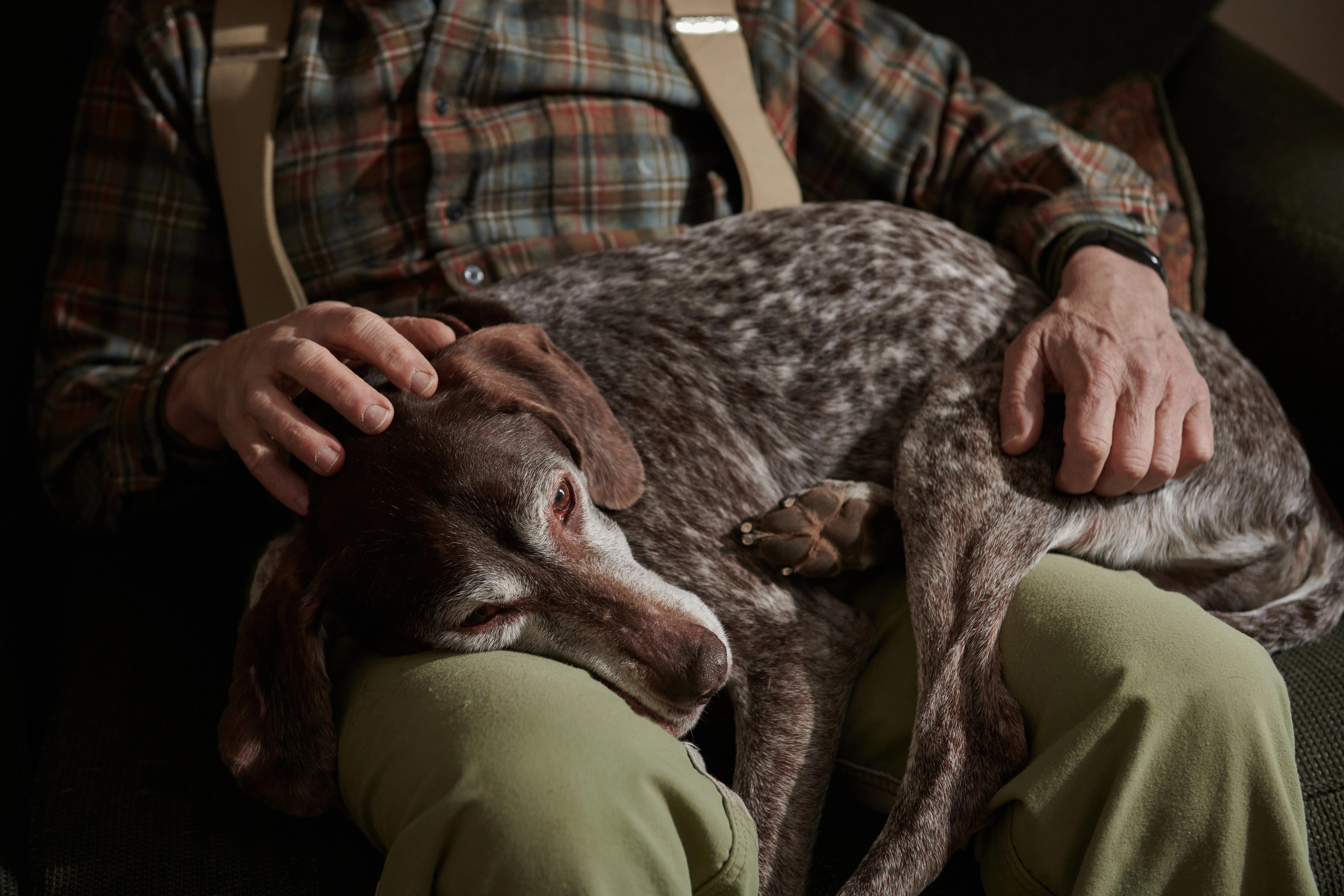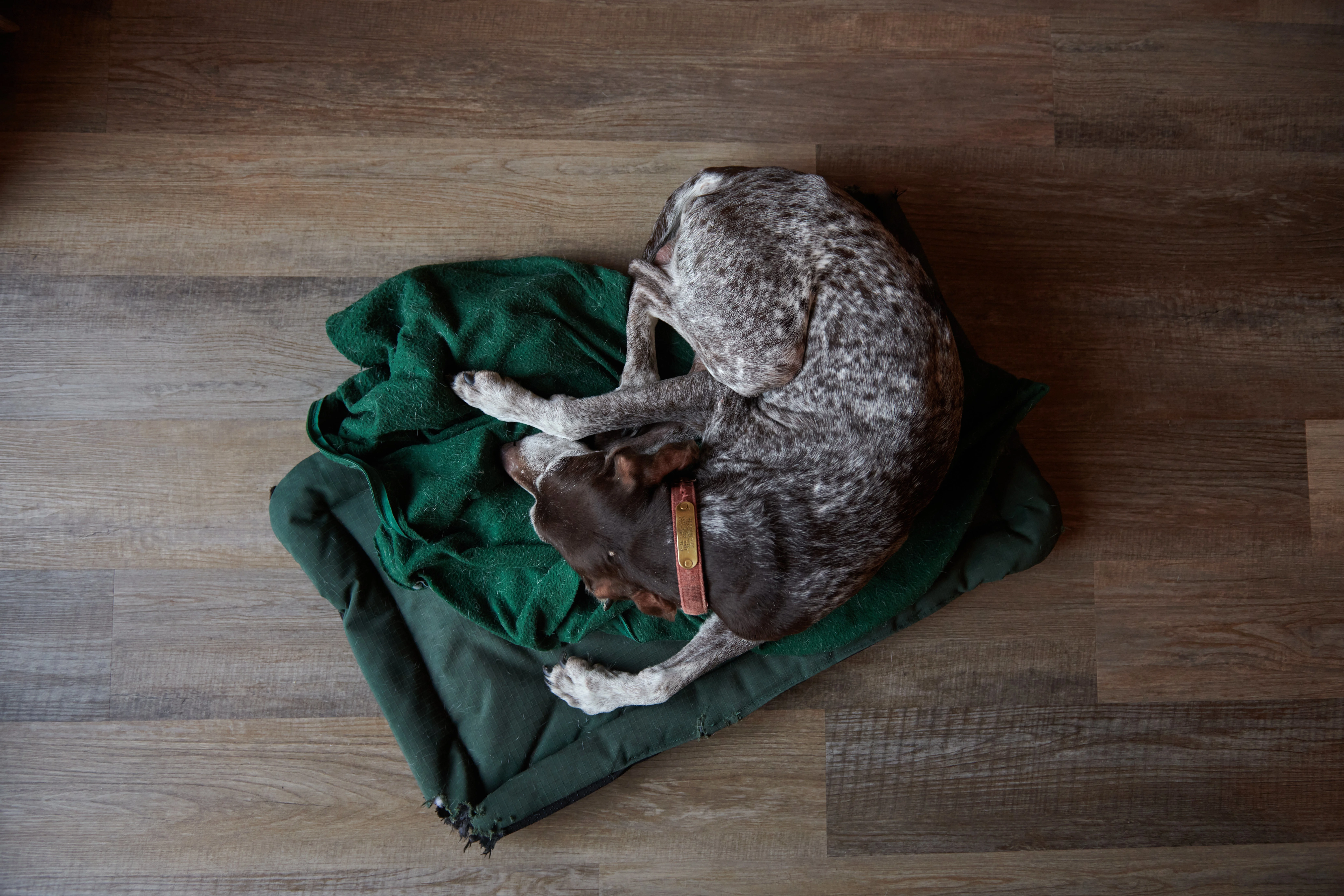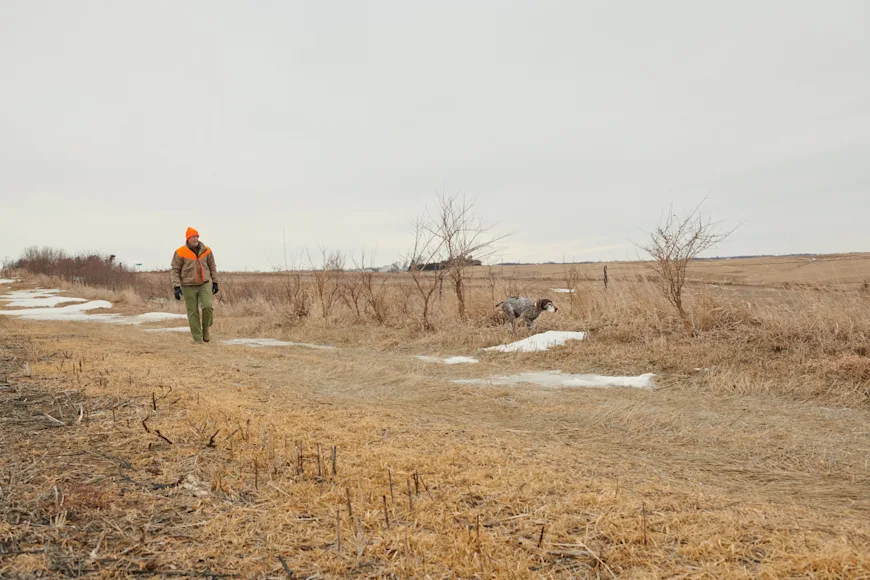Jed froze on point, keeping his tail down the old-fashioned way, the same way he had for 14 seasons. Crouched, with his nose almost touching the ground, he was showing me that the bird was right there. I stepped forward, and the pheasant busted out of the grass and into the trees on the creekbottom. Roosters in the woods are my pheasant-shooting Achilles’ heel, and I only made my chances worse by thinking, I shouldn’t miss Jed’s last bird. So I missed it twice. To my surprise, I didn’t care at all. Neither did Jed. We hunted for an hour, and I wore a smile the whole time as my old dog puttered around the field.
Jed was skinny even before the years robbed him of muscle and left him slightly hunched. His liver-ticked coat remains dark, while the white on his muzzle recently linked up with the white over his brows, making a white mask around dark eyes and a dark strip down his nose. It reminded me of a Spartan helmet—but the white made Jed look winsome, not fierce.
Jed pointed a hen, then I kenneled him up and, for the last time, took him home.

Since his days as a pup, Jed has always enjoyed cuddling with the family at home. Dan Brouillette
The First Season
I brought Jed home the first time in the summer of ’08. He was a 10-week-old GSP—the last puppy left in the litter, which maybe should have been a red flag. But I had started the search to replace my English setter, Ike
, late and I needed a dog for the fall. I wrote a check that would turn out to be one of the smaller ones I would write for this dog.
His kennel name was Otto, which I decided was too on point for a German dog. However, as a terrible, unoriginal dog namer, I had no idea what to replace “Otto” with. I held a contest and let Field & Stream readers name my dog. I printed out the list of hundreds of suggested names, and the whole family spent a weekend sifting through them. After all that, “Jed” won. The name was short, sturdy, and easy to yell. And it went well with “Ike.”
Learn how to upgrade your membership plan and get the new print magazine!
Jed was 6 months old when his first season started. Ike could still hunt, and I ran the two together—me following my old dog, Jed following me—until the day Jed strayed off on his own and went on point. That bird flushed before I could get to it, and after that I started following the young dog. Halfway through the season, Jed surprised me with his first retrieve. I shot a bird that fell across a shallow creek with steep banks, and Jed, who had shown no interest in fetching at all, went down one side and up the other and came back with the bird in his mouth. One wing covered his eyes, which meant he’d had to make the trip back to me by feel. I crossed “force fetch” off my mental to-do list. Jed was a natural.
On the last day of that puppy season, Ike backed while Jed pointed my limit. I shot a single, then Jed pointed in the fenceline at the edge of the field. When I stepped in, two roosters flushed. I shot them both, then realized what had just happened: I’d shot one of my very few true doubles on wild birds, and my puppy, only 9 months old, had pointed them. I had a feeling then that I might be in for a decade or more of greatness.
I try to tell myself that the short lives of dogs are a feature, not a bug, because we get to lovemore than one dog in our lifetime.
About a month after the wild bird season closed, I was invited to a preserve to hunt. I asked if I might bring my puppy, even though I knew there would be some very good dogs. Jed left them in the dust. He pointed every bird we shot that day. Hogging all the points wasn’t enough, though. Jed insisted on making all the retrieves, and when he couldn’t get to one of the birds first, he took it out of the other dog’s mouth. By the end I was embarrassed by my mannerless dog—although a part of me was thrilled at what I seemed to have in Jed.
He was a hard charger in the field—too hard charging, I’d eventually learn—but at home was endearing and affectionate, if clingy, and his sweet nature made him my wife’s all-time favorite dog. As a fixture in my office, Jed became my best coworker, content to sleep at my feet while I wrote, ready to play when I needed a break, and always wanting to be wherever I was.
Appetite for Destruction
Life with Jed was going very well—up until the day my wife couldn’t find a pair of her tights. She couldn’t find them because they were inside the puppy, stuck in his intestines. We didn’t know that at the time, only that he couldn’t keep food down and not much was coming out the other end either, and what did was tarry and bloody. We didn’t put two and two together until after I picked Jed up from surgery and the emergency vet gave me a zip-close bag containing the tights and one sock, both reeking of dog intestine.
Dogs eat a lot of things, and for the most part they’re like garbage disposals, with strong stomach acids and short intestines that let them process foods that would make us sick. But they can’t eat everything, and dogs with a disorder called pica have a compulsion to eat nonfoods, many of which won’t pass through their intestines: dirt, rocks, rubber dog toys, socks. Jed was a pica puppy, and he specialized in hosiery. When a dog suffers intestinal blockage, if the blockage is not removed, the dog dies.
That first surgery wasn’t cheap, but it wasn’t too dangerous either: There was a 90 percent chance of survival. Even so, I am an anxious enough dog owner that a 1-in-10 chance he wouldn’t make it kept me up until the vet called that night telling me Jed could come home. He banged around the house with a plastic cone on his head and staples in his stomach for 10 days, and we went on, assuming it was a one-time disaster.
Drastic Measures
The second time Jed ate a pair of tights, the doctor told me the surgery was riskier because of scar tissue from the first operation. She told me too that he couldn’t afford to keep losing sections of his intestine, that he wouldn’t be able to absorb nutrients properly. I couldn’t sleep much, waiting for word from surgery, but the vet called late at night again and said Jed was waking up and seemed fine. The next morning, he came back with another cone on his head and more staples. In hindsight, a zipper would have made subsequent surgeries easier. Some dogs age out of pica; some never do. Some must be put down; some don’t live through surgery. Jed’s twisted, scarred intestines would no longer pass even a thin sock. If one went missing and I found out right away, I could give Jed hydrogen peroxide, and he’d throw it up before it lodged. We got good at policing socks, and it got easier when the kids moved out of the house. Still, Jed wasn’t done. In the absence of socks, he ate a box of leather watchbands.
Despite the doctor’s warnings that every surgery might be the last, Jed pulled through them all. It finally occurred to me—much later than it should have—that if I couldn’t dog-proof the house, I could house-proof the dog. I ordered a muzzle made of clear, vented plastic. Supposedly the dog could drink with the muzzle on but couldn’t eat anything. I called the man who had made the muzzle and asked how to train a dog to wear it. “Put it on him and spray some Cheez Whiz through one of the holes,” he said. “They love it.”
Jed would stand on his hind legs and crane his neck trying to get every lick of cheese inside the muzzle. Once it was gone, he had no use for the muzzle, but it was too late by then. He was safe.

Jed taking a snooze on his bed—not too far from where the author does his writing. Dan Brouillette
Hard Lessons
Prevented from killing himself with socks and watchbands, Jed got creative in finding ways to get hurt in the field. Most involved barbed wire, but he also came back from one hunt with a tiny speck of weed debris stuck to his cornea. Eyewash wouldn’t budge it, and the vet told me Jed would lose the eye to infection if it didn’t come out. There happened to be a veterinary eye clinic in the next town that had the necessary microsurgery tools and training to safely remove vegetal debris and perform the graft afterward.
It turns out that removing a small piece of weed from a dog’s eye costs more than twice as much as cutting an entire pair of pantyhose out of his intestines. My wife saw the bill and insisted Jed hunt in goggles for the rest of his life. I asked a dog trainer for a second opinion.
“You’ll put a million miles on that dog before it ever happens again,” he said. I decided we’d take our chances. The next year, Jed came home from a hunt sneezing so violently that blood dripped from his nose. The emergency vet extracted a 4-inch prairie grass stem lodged so far up his right nostril that you couldn’t see the end of it. All I could think was what an idiot I’d have felt like making him wear goggles only to have him jam a stick up his nose instead of into his eye.
It wasn’t just Jed who got hurt in the field. I was a victim of the Jed Effect once myself. Jed didn’t have the worst hard mouth I’ve seen, but you often had to eat around toothmarks in the pheasants he’d retrieved. If I could pick a bird up before Jed found it, I’d hustle over and get it. One morning Jed pointed a pheasant that flushed wild and cut back, giving me a long crosser. I missed, corrected, then killed it. The bird fell in a draw. I realized Jed hadn’t seen the bird fall and that I could get to it first. But then Jed saw me moving and started to head toward the bird. Since my gun was empty, what would it hurt to pick up the pace? Then I was running. Then I was flying. Then I was crashing. As I sat, dazed, with what turned out to be a broken arm, Jed picked the pheasant up and brought it to me without leaving a mark on it.
The Final Seasons
The next year, to my surprise, Jed turned 10. I had always assumed that if a surgery didn’t kill him, years of having pieces of his intestine cut away would shorten his life. It was our last season together before I got Zeke
, and we made the most of it. Jed stayed injury-free. There were plenty of birds that year, and there isn’t much a pheasant can do that will surprise an old dog. Jed still had surprises for me, though. He always hated water, so when I dropped a pheasant into a deep creek one day, I assumed I was on my own to fetch it until I heard a loud splash and then a dripping-wet Jed clambered up the vertical bank with the bird in his mouth. We stayed on a roll together that year all the way through to a limit on the last day.
Jed and Zeke became inseparable at home, but Jed has never liked sharing in the field, so I’d run the two dogs separately. Jed got to go first because he’d bark in protest if I took Zeke and left him in the truck. Going first meant his limit was one bird, because it was important to shoot as many pheasants as I could over Zeke. There were several days in Zeke’s first two seasons when I shot Jed’s one bird, then watched him handle four or five roosters perfectly while I saved the rest of the limit for Zeke. I didn’t mind. Without the need to shoot, I could concentrate on enjoying Jed at work. With Zeke in his third season and Jed content to sleep at home, I took him only half a dozen times, and I never did get that last bird shot over him.
Jed is home now. As I write this, he’s curled up with Zeke, forming the circle of bird dog life on an old fleece sleeping bag liner. He won’t leave the house again, except for walks and trips to the vet. He’ll turn 14 this spring, putting him on the outside edge of a GSP’s life span of 12 to 14 years.
But, as Ike gave way to Jed, now it’s time for Jed to give way to Zeke. I try to tell myself that the short lives of dogs are a feature, not a bug, because we get to love more than one dog in our lifetime. Fourteen years is a long time for a dog, and a large chunk of a human life too. For Jed, who has no sense of time passing, every day will be another happy day around the house, until one day it isn’t. Maybe he’s the lucky one—able to live entirely in the moment. Or maybe I am lucky, because I know his precious time is running short, and it reminds me to cherish him every day he’s here.
_This story was first published in the Home Issue in 2022. Read more stories exclusive to F&S members here
._






